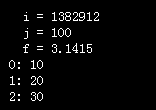C++new和delete的使用
<上一节
下一节>
基本数据类型的动态分配
new和delete已经完全包含malloc和free的功能,并且更强大、方便、安全。使用动态分配内存时不能忘记释放内存,不要忘记出错处理!下面先看new和delete的基本使用方法。
#include <iostream>
using namespace std;
int main ( )
{
//基本数据类型
int *i = new int; //没有初始值
int *j = new int(100); //初始值为100
float *f = new float(3.1415f); //初始值为3.14159
cout << " i = " << *i << endl;
cout << " j = " << *j << endl;
cout << " f = " << *f << endl;
//数组
int *iArr = new int[3];
for (int i=0; i<3; i++) {
iArr[i] = (i+1)*10;
cout << i << ": " << iArr[i] << endl;
}
//释放内存
delete i;
delete j;
delete f;
delete []iArr; //注意数组的删除方法
return 0;
}
输出结果:
内存分配时的出错处理
一般有2种处理方法,一是根据指针是否为空来判断,一是用例外出错处理所抛出的“bad_alloc”来处理。
#include <iostream>
#include <new>
using namespace std;
int main ( )
{
//判断指针是否为NULL
double *arr = new double[100000];
if (!arr) {
cout << "内存分配出错!" << endl;
return 1;
}
delete []arr;
//例外出错处理
try {
double *p = new double[100000];
delete []p;
} catch (bad_alloc xa) {
cout << "内存分配出错!" << endl;
return 1;
}
//强制例外时不抛出错误,这时必须要判断指针
double *ptr = new(nothrow) double[100000];
if (!ptr) {
cout << "内存分配出错!" << endl;
return 1;
}
delete []ptr;
cout << "内存分配成功!" << endl;
return 0;
}
输出结果:内存分配成功!
用new产生类的实例
前面已经用了很多了。
#include <iostream>
using namespace std;
class classA {
int x;
public:
classA(int x) { this->x = x; }
int getX() { return x; }
};
int main ( )
{
classA *p = new classA(200); //调用构造函数
if (!p) {
cout << "内存分配出错!" << endl;
return 1;
}
cout << "x = " << p->getX() << endl;
delete p; //调用析构函数
return 0;
}
运行结果:x = 200
<上一节
下一节>

